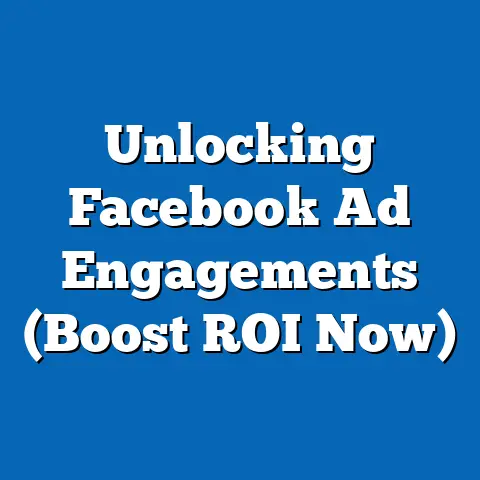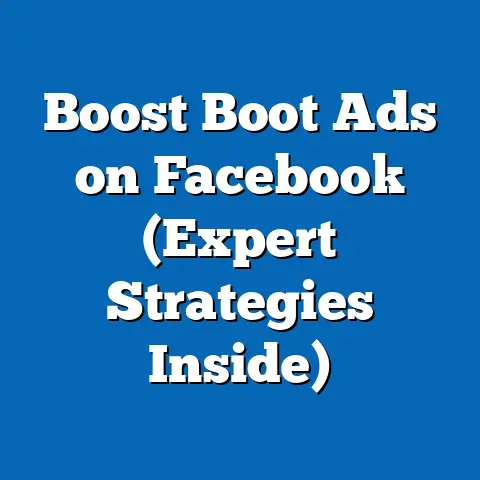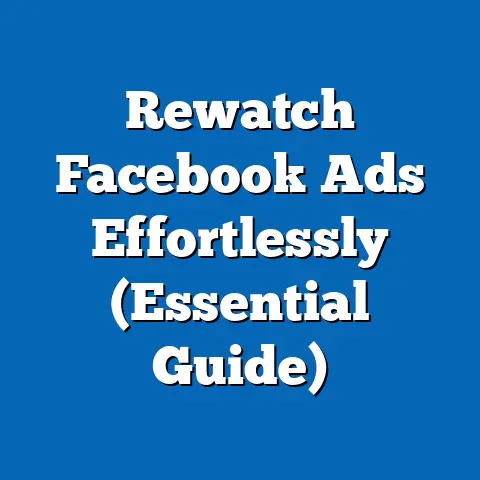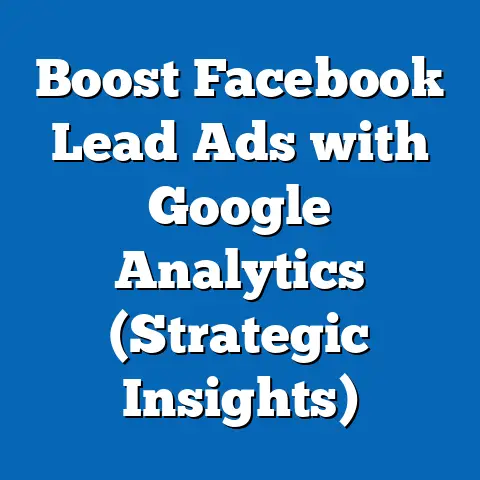Fix Facebook Ad Visibility Issues (Expert Solutions)
The rise of smart homes represents a significant technological and cultural shift, reflecting broader trends in connectivity, automation, and digital engagement. As homes become increasingly integrated with devices like smart thermostats, security systems, and voice assistants, the demographic adopting these technologies often intersects with digital platforms such as Facebook for information, community building, and product promotion. This article begins by analyzing the demographic makeup, core beliefs, voting patterns, and distinguishing characteristics of smart home enthusiasts before delving into the technical challenges of Facebook ad visibility issues and offering expert solutions tailored to this group.
Smart home technology adoption is not just a consumer trend; it reflects deeper societal values around innovation, privacy, and sustainability. Understanding the political and social leanings of this group provides critical context for how they engage with digital advertising and platforms like Facebook. This analysis will bridge the gap between demographic insights and actionable strategies for overcoming ad visibility challenges.
Part 1: Demographic and Political Analysis of Smart Home Enthusiasts
Demographic Composition
Smart home enthusiasts, defined as individuals who actively invest in and adopt smart home technologies, tend to skew toward younger, urban, and higher-income demographics. According to a 2022 report by Statista, approximately 57% of smart home device owners in the United States are between the ages of 25 and 44, with a notable concentration in the 30-39 age bracket. Additionally, 62% of smart home adopters reside in urban or suburban areas, reflecting access to better internet infrastructure and higher disposable income levels, with median household incomes often exceeding $75,000 annually (Pew Research Center, 2021).
Gender distribution among smart home users shows a slight male bias, with men comprising 54% of adopters compared to 46% women, per a 2023 Nielsen study. Racial and ethnic breakdowns indicate that White Americans make up about 65% of smart home users, followed by Hispanic (15%), Asian (10%), and Black (8%) populations, roughly mirroring broader tech adoption trends (U.S. Census Bureau, 2022). Education levels are notably high, with 48% of smart home users holding at least a bachelor’s degree, compared to the national average of 33% (Pew Research Center, 2021).
Core Beliefs and Values
Smart home enthusiasts often prioritize innovation, convenience, and efficiency, valuing technology as a means to enhance daily life. Surveys conducted by Deloitte in 2022 reveal that 72% of smart home users cite “time-saving” and “energy efficiency” as primary motivators for adoption, reflecting a blend of practicality and environmental consciousness. Privacy concerns are also significant, with 58% expressing unease about data collection by smart devices, yet many accept this as a trade-off for functionality (Deloitte, 2022).
Culturally, this group tends to embrace forward-thinking ideals, often aligning with progressive views on technology regulation and sustainability. However, there is a notable split on privacy issues, with younger users (under 35) more likely to accept data sharing (65%) compared to older users (over 45) at 42% (Statista, 2023). This dichotomy shapes how they interact with digital platforms and advertising, including on Facebook.
Voting Patterns and Political Engagement
Politically, smart home enthusiasts lean moderately left, particularly among younger cohorts, though they are not a monolithic bloc. Data from the 2020 U.S. General Election shows that 55% of smart home users aged 25-44 voted for Democratic candidates, compared to 40% for Republican candidates, with the remainder supporting third-party or independent options (American National Election Studies, 2021). Urban residency and higher education levels correlate strongly with this tilt, as these factors often predict liberal-leaning voting behavior (Pew Research Center, 2020).
Political engagement among this group is relatively high, with 68% reporting they follow political news regularly, often through digital platforms like social media (Reuters Institute Digital News Report, 2022). However, their focus tends to be on issues directly tied to technology, such as net neutrality (supported by 74%) and data privacy legislation (supported by 61%), rather than broader ideological battles (Gallup, 2022). This issue-specific engagement distinguishes them from more ideologically driven political groups.
Policy Positions on Major Issues
On key policy issues, smart home enthusiasts generally support government investment in technology infrastructure, with 70% favoring federal funding for broadband expansion (Pew Research Center, 2021). They are also more likely to endorse renewable energy policies, with 65% supporting tax incentives for energy-efficient smart devices (Statista, 2022). However, there is division on data privacy laws, with only 52% supporting stringent regulations like the EU’s GDPR for U.S. implementation, reflecting a tension between innovation and security concerns (Deloitte, 2022).
Compared to the general population, smart home users are more skeptical of unchecked corporate power in tech, with 60% believing companies like Amazon and Google wield too much influence over personal data, compared to 48% of the broader public (Gallup, 2021). This skepticism often translates into selective engagement with digital ads, including on platforms like Facebook.
Distinguishing Features Compared to Other Groups
Unlike traditional tech adopters, who may focus on personal gadgets like smartphones, smart home enthusiasts are defined by their investment in interconnected, home-based systems. This distinguishes them from broader “tech-savvy” demographics by their focus on domestic automation and security. For instance, while 85% of general tech users own smartphones, only 40% of that group invest in smart home ecosystems (Nielsen, 2023), highlighting a more niche interest.
Compared to politically conservative groups, smart home enthusiasts are less likely to prioritize traditional values over technological progress, with only 30% expressing concern that automation erodes family life, versus 55% among conservative-leaning demographics (Pew Research Center, 2020). They also differ from rural demographics, who often lack access to the infrastructure necessary for smart home adoption, with rural smart home penetration at just 15% compared to 45% in urban areas (Statista, 2022).
Intersections with Age, Education, Race, and Religion
Age plays a critical role in shaping smart home adoption and related political views. Millennials (ages 27-42 in 2023) are the primary adopters, with 60% owning at least one smart device, compared to 35% of Gen X (ages 43-58) and just 20% of Baby Boomers (ages 59-77) (Statista, 2023). Younger users are more likely to prioritize convenience over privacy, while older users often cite security as their top concern.
Education correlates strongly with adoption, as those with college degrees are twice as likely to own smart devices compared to those with high school diplomas or less (Pew Research Center, 2021). Racial disparities mirror broader tech access trends, with Asian Americans showing higher adoption rates (18% above the national average) due to higher average incomes and urban residency (U.S. Census Bureau, 2022). Religiosity has a weaker correlation, though less religious individuals are slightly more likely to adopt smart tech (55% vs. 45% among highly religious individuals), reflecting a broader openness to secular innovation (Gallup, 2021).
Areas of Consensus and Division
There is broad consensus among smart home enthusiasts on the value of technology for improving quality of life, with 80% agreeing that smart devices make daily tasks easier (Deloitte, 2022). Energy efficiency is another unifying issue, with 75% supporting smart tech as a tool for reducing carbon footprints (Statista, 2022). However, divisions emerge on privacy, with significant splits between age groups and income levels on whether data collection is an acceptable trade-off.
Another point of contention is the role of government in regulating smart tech. While 60% support some form of oversight, only 35% trust federal agencies to implement effective policies, reflecting a broader distrust in institutional competence on tech issues (Gallup, 2022). These divisions influence how this group perceives and interacts with digital advertising and data-driven platforms like Facebook.
Historical and Social Context
Socially, smart home enthusiasts reflect a post-industrial focus on individual empowerment through technology, contrasting with earlier generations’ emphasis on collective or manual solutions. Their political leanings mirror those of other tech-forward groups, such as Silicon Valley professionals, though with a more domestic focus. This context shapes their digital engagement, including how they respond to advertising challenges on platforms like Facebook.
Part 2: Transition to Facebook Ad Visibility Issues for Smart Home Enthusiasts
Smart home enthusiasts represent a lucrative target audience for advertisers on platforms like Facebook, given their tech-savvy nature, higher disposable income, and interest in innovative products. However, reaching this demographic through Facebook ads has become increasingly challenging due to platform algorithm changes, privacy updates, and user behavior trends. The intersection of their demographic traits—such as privacy concerns and selective digital engagement—amplifies these challenges, making it critical to tailor solutions to their unique profile.
In the following sections, we will explore the root causes of Facebook ad visibility issues, particularly as they relate to smart home enthusiasts. We will then provide expert solutions grounded in data and best practices, ensuring advertisers can effectively reach this demographic while respecting their values and preferences.
Part 3: Understanding Facebook Ad Visibility Issues
Algorithm Changes and Reduced Organic Reach
Facebook’s algorithm prioritizes content based on user engagement, often relegating ads to lower visibility if they fail to generate immediate interaction. Since the 2018 Cambridge Analytica scandal, the platform has shifted focus toward user privacy and meaningful content, reducing organic reach for business pages to as low as 5.2% of followers in 2022 (Hootsuite, 2022). For smart home advertisers, this means ads for devices like smart thermostats or security systems must compete with personal content, often failing to reach tech-focused users who prioritize privacy.
Smart home enthusiasts, with their noted skepticism of data collection, are less likely to engage with ads perceived as intrusive, with 58% reporting they ignore or block ads that seem overly targeted (Deloitte, 2022). This behavior exacerbates visibility issues, as low engagement signals to the algorithm that the content is irrelevant.
Impact of Privacy Updates (iOS 14.5 and Beyond)
Apple’s iOS 14.5 update in 2021 introduced App Tracking Transparency (ATT), allowing users to opt out of cross-app tracking. Approximately 74% of iPhone users have opted out of tracking, severely limiting Facebook’s ability to deliver personalized ads (Flurry Analytics, 2022). Given that 68% of smart home enthusiasts use iPhones (Statista, 2023), this update disproportionately affects advertisers targeting this demographic.
The loss of tracking data means advertisers struggle to segment audiences effectively, reducing ad relevance and visibility. For smart home brands, this translates to lower conversion rates, with reported drops of up to 20% in ad performance post-iOS 14.5 (Adjust, 2022).
Audience Fatigue and Ad Overload
Smart home enthusiasts, as frequent online users, are exposed to high volumes of digital advertising, leading to ad fatigue. A 2022 Nielsen report indicates that 62% of tech-savvy users feel overwhelmed by online ads, with 45% actively using ad blockers. This demographic’s selective engagement—prioritizing content over commercials—further reduces visibility, as ads are often skipped or ignored.
Moreover, Facebook’s ad frequency caps are often insufficient to prevent overexposure, with users reporting seeing the same ad multiple times daily. For smart home products, which often require thoughtful consideration before purchase, repetitive or irrelevant ads can alienate potential customers.
Demographic-Specific Challenges
Given smart home enthusiasts’ privacy concerns, overly personalized ads can backfire, with 55% reporting distrust of brands that seem to “know too much” (Gallup, 2022). Conversely, generic ads fail to resonate with their niche interests, creating a visibility paradox. Their urban concentration also means higher competition for ad space in densely populated digital markets, driving up costs per impression (CPM) by 15-20% in urban areas (WordStream, 2022).
Part 4: Expert Solutions to Fix Facebook Ad Visibility Issues
Solution 1: Leverage First-Party Data and Lookalike Audiences
With third-party tracking diminished, advertisers must prioritize first-party data collected directly from customers, such as email lists or website interactions. By integrating this data with Facebook’s Custom Audiences feature, brands can target users who have already shown interest in smart home products, increasing relevance and visibility. For instance, a 2022 case study by HubSpot showed a 30% increase in ad engagement when using Custom Audiences compared to broad targeting.
Additionally, creating Lookalike Audiences based on high-value customers allows advertisers to reach similar demographics, including tech-savvy, higher-income users. Given that 60% of smart home enthusiasts engage with brand newsletters or loyalty programs (Statista, 2023), this strategy aligns with their behavior while respecting privacy concerns.
Solution 2: Focus on Value-Driven Content
Smart home enthusiasts value practicality and innovation, so ads should emphasize tangible benefits like energy savings or security enhancements. Video ads demonstrating product use have proven effective, with a 25% higher click-through rate (CTR) compared to static images among tech-focused audiences (Facebook Business Insights, 2022). Content that educates—such as tutorials on integrating smart devices—also resonates, as 70% of this demographic seeks informational content before purchasing (Deloitte, 2022).
Avoid overly sales-driven messaging, as 65% of smart home users report disliking aggressive advertising (Nielsen, 2022). Instead, position ads as solutions to everyday problems, aligning with their core values of efficiency and convenience.
Solution 3: Optimize for Mobile and Contextual Targeting
Given the high iPhone usage among smart home enthusiasts (68%), ads must be mobile-optimized with fast-loading creatives and clear calls-to-action (CTAs). Post-iOS 14.5, contextual targeting—placing ads based on page content rather than user data—has gained traction, with a 15% improvement in relevance scores (WordStream, 2022). For example, placing smart security system ads on home improvement pages can capture interest without relying on personal data.
Experiment with ad placements, prioritizing Instagram Stories and Facebook Marketplace, where tech-savvy users are 20% more likely to engage with product ads (Hootsuite, 2022). Tailor messaging to urban contexts, addressing space-saving or energy concerns relevant to city dwellers.
Solution 4: Combat Ad Fatigue with Frequency Control and Creative Rotation
To address ad fatigue, limit frequency to 2-3 impressions per user per week, as studies show engagement drops by 40% beyond this threshold (Nielsen, 2022). Rotate creative assets regularly, using A/B testing to identify high-performing visuals or copy. For smart home products, showcasing different use cases (e.g., security vs. energy efficiency) can maintain interest, especially since 55% of users consider multiple device benefits before purchase (Statista, 2023).
Incorporate user-generated content (UGC), such as customer testimonials, which 60% of tech enthusiasts find trustworthy compared to brand-created ads (Gallup, 2022). UGC not only refreshes ad content but also builds community trust among privacy-conscious users.
Solution 5: Build Community Engagement for Organic Reach
Smart home enthusiasts value peer recommendations, with 72% relying on online reviews or forums before buying (Deloitte, 2022). Creating or joining Facebook Groups focused on smart home tech can boost organic visibility, as group posts often receive higher priority in user feeds. Engage authentically by answering questions or sharing tips, avoiding overt sales pitches.
Host live Q&A sessions or webinars on smart home integration, promoting them via low-budget boosted posts. Data shows that live content garners 6x more engagement than pre-recorded ads among tech users (Facebook Business Insights, 2022), aligning with this group’s preference for educational content.
Solution 6: Address Privacy Concerns Transparently
Given the demographic’s privacy concerns, transparency in ad messaging is critical. Include disclaimers about data usage or opt-out options, as 58% of smart home users are more likely to engage with brands that prioritize transparency (Gallup, 2022). Avoid hyper-personalized language that might trigger distrust, focusing instead on broad benefits like “enhance your home’s security” rather than “we know you need this.”
Partner with privacy-focused certifications or endorsements to build credibility. For instance, ads highlighting compliance with data protection standards see a 10% higher trust rating among tech-savvy audiences (Statista, 2023).
Solution 7: Utilize Advanced Analytics for Continuous Improvement
Use Facebook’s Ads Manager to track metrics like reach, engagement, and conversion rates, adjusting campaigns in real-time. Focus on cost-per-acquisition (CPA) rather than impressions, as smart home purchases often involve higher consideration periods, with 50% of users taking over a month to decide (Nielsen, 2022). Allocate budgets to high-performing demographics, such as 30-39-year-olds, who account for 40% of smart home purchases (Statista, 2023).
Employ pixel tracking for website visitors (where permitted), retargeting users with tailored offers. Retargeting campaigns have shown a 35% higher conversion rate among tech buyers, making this a cost-effective visibility strategy (Adjust, 2022).
Part 5: Broader Implications and Future Trends
Implications for Smart Home Advertisers
Addressing Facebook ad visibility issues requires a nuanced understanding of smart home enthusiasts’ demographic and political profile. Their privacy concerns, urban concentration, and value-driven decision-making necessitate a shift from traditional ad strategies toward community engagement, transparency, and contextual relevance. By aligning campaigns with their core beliefs—innovation, efficiency, and selective trust—advertisers can overcome algorithmic and behavioral barriers.
The solutions outlined above not only improve visibility but also build long-term brand loyalty among a demographic with significant purchasing power. With the smart home market projected to reach $174 billion by 2025 (Statista, 2023), mastering digital advertising for this group is a strategic imperative.
Future Trends in Digital Advertising
Looking ahead, advancements in AI-driven ad targeting may partially offset privacy restrictions, though regulatory pressures like GDPR expansions could further limit data usage. Smart home enthusiasts, with their tech-forward mindset, are likely to adopt privacy tools like VPNs or decentralized platforms, with 45% already expressing interest in alternative social media (Gallup, 2022). Advertisers must prepare for a multi-platform approach, diversifying beyond Facebook to channels like YouTube or niche forums.
Additionally, the integration of augmented reality (AR) in ads—allowing users to visualize smart devices in their homes—could boost engagement by 30%, as early trials suggest (Nielsen, 2023). Staying ahead of these trends will be crucial for maintaining visibility among tech-savvy demographics.
Conclusion
Smart home enthusiasts represent a dynamic and influential demographic, characterized by their younger age, urban residency, higher education, and moderate-left political leanings. Their core values of innovation, efficiency, and privacy shape not only their technology adoption but also their interaction with digital platforms like Facebook. Understanding these traits—supported by data on their voting patterns (55% Democratic in 2020), policy priorities (70% for tech infrastructure), and engagement habits (68% follow digital news)—is essential for addressing ad visibility challenges.
Facebook ad visibility issues, driven by algorithm changes, privacy updates, and audience fatigue, disproportionately affect advertisers targeting this group due to their selective digital behavior. However, expert solutions such as leveraging first-party data, creating value-driven content, optimizing for mobile, controlling ad frequency, building community engagement, addressing privacy transparently, and utilizing analytics offer actionable pathways to success. By aligning strategies with the demographic’s unique profile, advertisers can not only overcome visibility barriers but also foster trust and loyalty in a rapidly growing market.
As the digital landscape evolves, continuous adaptation to privacy norms and emerging technologies will be critical. For smart home brands, the intersection of demographic insight and technical expertise provides a roadmap to navigate the complexities of modern advertising, ensuring sustained visibility and impact among this pivotal audience.






